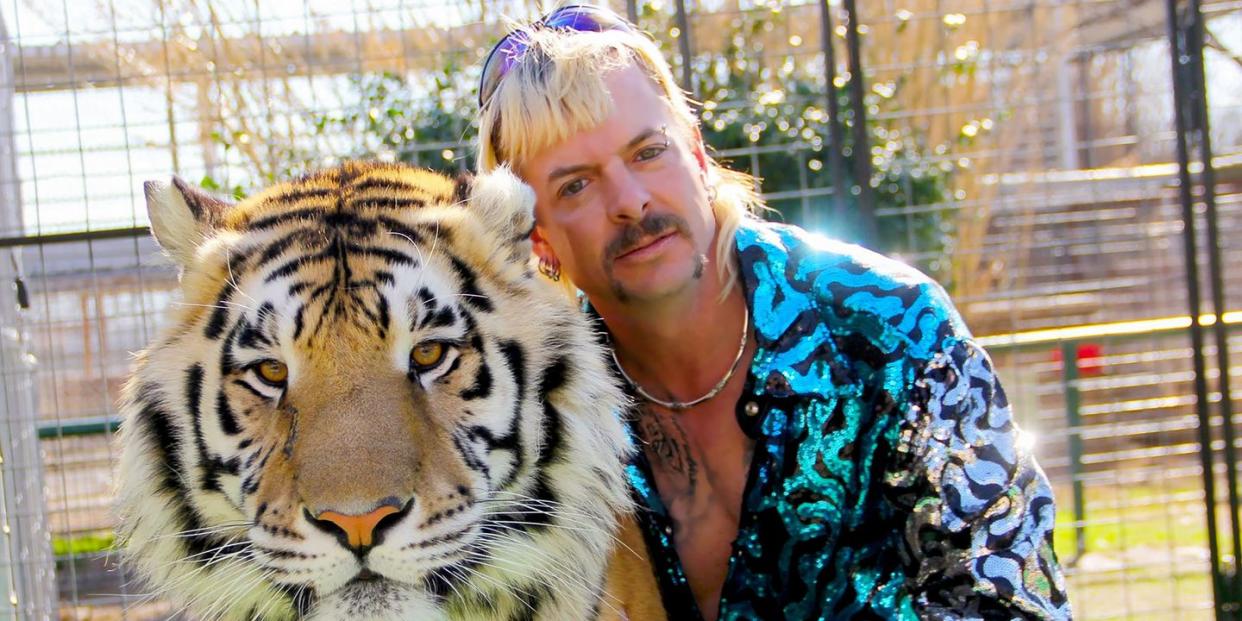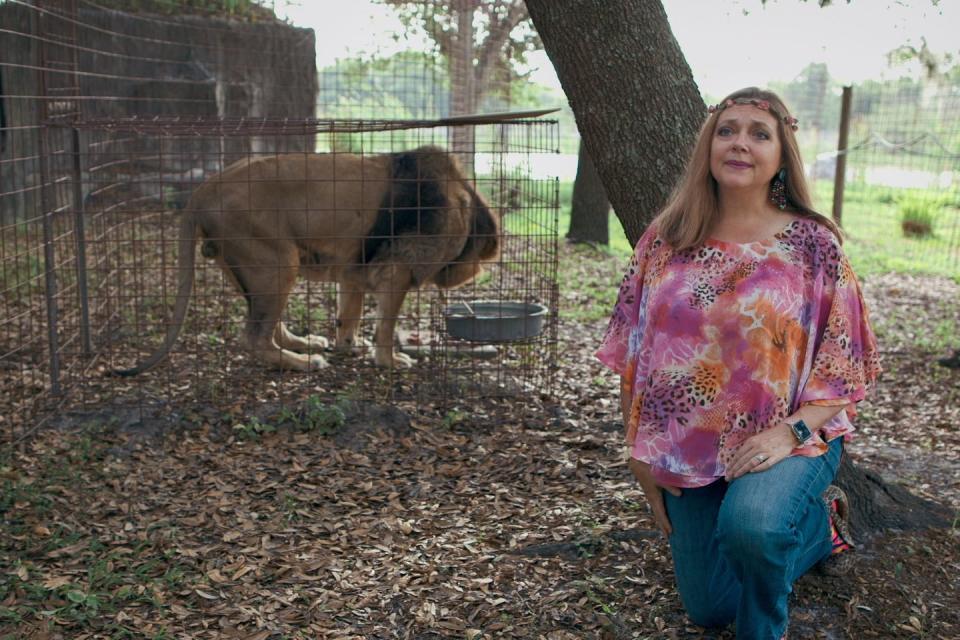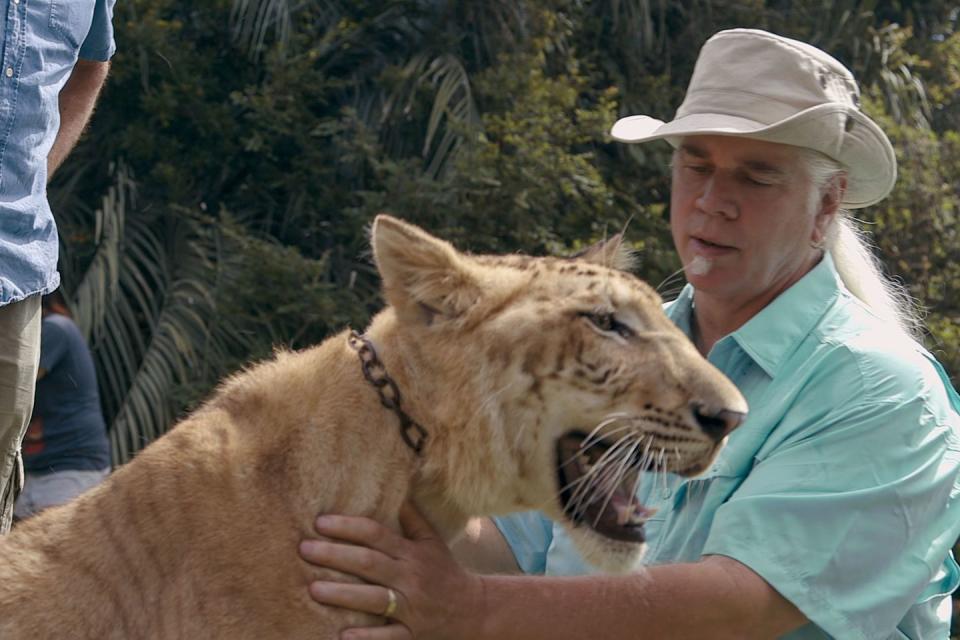Tiger King: Joe Exotic and Doc Antle are not a joke… so why are we romanticising them?

Tiger King has become a huge Netflix hit over the past few weeks. A mix of horrifying, mystifying and compelling, the seven-part documentary trails notorious wild cat owners in the US, with a special focus on Joe Exotic - a gun-toting, flamboyant, publicity-hungry zoo owner living in Oklahoma.
PETA US’ director of Captive Animal Law Enforcement, Brittany Peet, who featured in Tiger King's first and last episode, has an insider view of what really goes on at GW Exotic and Big Cat Rescue. Here, she dispels inaccuracies portrayed in the series, and questions why we are giving a man as morally bankrupt as Joe Exotic any airtime at all.
I first interviewed for Tiger King at a conference I was speaking at in California several years ago. A colleague of mine introduced me to one of the directors, Eric Good, and I sat down for an interview with him that day to talk about a lot of different things. From then, I talked to them more and more, but ultimately sat down for interviews four times over the course of the years.
I’ve been doing this work for 10 years, so I’ve known Joe Exotic since then. For all of that time, he’s been public enemy number one in terms of captive animal abuse. He has pumped out hundreds, likely thousands, of big cat cubs over the years and sold them indiscriminately to anyone with no regard of what they might do to them. The first time that I met Joe, he told me that a lot of the places he sells cubs to kill them after they’ve aged out of cub-petting. He told me the same day that Doc Antle puts cubs in gas chambers and incinerates their bodies in his on-site crematorium. He told me others hit the cubs over the head with a hammer and kill them that way.
He sent cubs to animal abuser (who also features on the docu-series) Tim Stark knowing that he subjected his cubs to painful declawing surgery, where their claws are removed so that they’re easier to interact with. It’s not like pulling off a human fingernail, big cat claws are attached to the joint. It would be like amputating our fingers at the second joint. Even when it’s done best, it causes long-term lameness and significant health problems. At worst, it causes infection and death which is what happened with Tim. Joe knew that, but he continued sending cubs to him because he didn’t care. He cares about the $2,500 that he charged for those animals.
As outlandish and funny as he may seem, I know perhaps better than anyone, how cruel Joe is and how little regard he has for the animals he has thrown to the wolves over the years. One of the commonalities among these people, and I think it’s obvious when you watch the series, is that they’re all narcissists. Joe especially will talk to anyone who will listen. From the moment I met him, despite the fact he burnt a PETA effigy and promised to shoot anyone from PETA who came on-site – he even threatened me directly via his YouTube show – he was laughing and spilling his guts about these people who are supposed to be his allies.
This all happened in November 2017, when things were heating up with Big Cat Rescue attempting to collect their judgement against him. Joe was starting to feel cornered, and he saw PETA as a potential lifeline. That’s one of the reasons that he talked so openly about others because he thought that PETA could help him get out of this. We were at least able to rescue 39 tigers, two baboons and the chimpanzees that you saw in the series out of GW and into reputable sanctuaries.

Tiger King does not accurately portray Big Cat Rescue. I have worked with Howard and Carole for years… they’re very dedicated to ending neglect and abuse to wild cats in captivity in the US and they’re effective at what they do. Big Cat Rescue does not breed, it does not buy or sell or allow any direct contact between big cats and humans. That is a big distinction. Another key difference is that Carole’s facility is a non-profit – she’s not trying to make money off the animals, whereas Jeff Lowe and the others are lining their pockets off the back of the animals. They’re trying to squeeze as much money out of them as they can in that short three-month window when they’re cubs and before they’re killed.
Carole’s facility is also accredited by a body called Global Federation of Animal Sanctuaries, which has the highest standards of any accrediting body for captive wildlife, mandating things like minimum enclosure size, enrichment, appropriate diet and succession plans. I have been there many times and I can say that Big Cat Rescue’s animal enclosures are made to look smaller than they are on the series. As important as space is complexity and Big Cat Rescue has an excellent environmental enrichment programme. What this means is that, not only are there natural elements in each of the enclosures such as dirt substrate, water features and shady structures, but every day the workers come up with different activities for the animals that encourage big cat behaviour that allow them to engage their brains and make them healthy, unlike what you see at roadside zoos where animals pace back and forth every day in these concrete floor cages. There’s a huge gulf in care between what you see at GW Exotic and Big Cat Rescue.

Another point I’d like to put right is Tim Stark’s claim that the way to get certain wild cats off endangered species lists is to breed them in facilities like his. The big problem with that idea is that all of the big cats that are being bred in such environments are what are known as generic tigers. They are a mixed sub-species. They are not the Bengal tigers you would find in India, or the Sumatra tigers, they’re hybrids of all of them. These animals have no conservation value, they can’t be released into the wild – they simply wouldn’t survive. It’s a misleading line that these abusers use to dupe well-meaning consumers into paying for encounters with tiger cubs. He is also contributing to the perception of endangered species when they’re used in entertainment – when viewers see endangered species in places like roadside zoos, they are given the misimpression that the animals don’t need help in the wild. Not only is Tim Stark not helping conservation efforts, he’s actually hurting them. He’s also abusing and killing animals in the process.

If you want to help grow the number of animals on endangered species lists, then invest in projects that conserve their habitats in the wild, for example initiatives that prevent poaching and that help to solve the human tiger conflict issues.
Tiger King is certainly not the series PETA would have made, but it’s certainly captured the world’s attention and it started a great dialogue about tigers in roadside zoos and the recent phenomenon of using baby tigers and photo opps with the public. People are starting to ask questions for what that means for the lives of the animals.

Our big worry is, just as we’re on the precipice of ending this industry, a docu-series like Tiger King could glamourise someone like Joe and drive people to do tiger cub encounters. For the most part, while people may see Joe as a joke, they do also seem to be taking a serious message away from Tiger King – that these men are dangerous criminals abusing animals, and in some instances, grooming women too. These people aren’t caricatures, they’re real people. It’s important for all of us not just to see this as a joke, but also a call to action to get these animals away from these awful people.
In need of some at-home inspiration? Sign up to our free weekly newsletter for skincare and self-care, the latest cultural hits to read and download, and the little luxuries that make staying in so much more satisfying.
You Might Also Like


